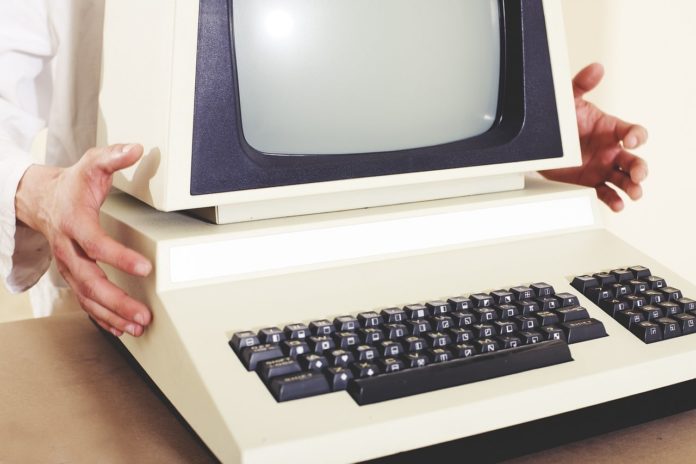
There’s a lot of speculation over the Internet of Things (IoT) and blockchain technology. Is it a match made in heaven? Do they reinforce each other’s strengths–or do the technologies clash? Should they occupy separate worlds that don’t overlap? And what exactly is the Internet of Things anyway?
When Dinosaurs Roamed the Earth
During the personal computer revolution of the 1980s, tech companies strove to build a world where every desktop held a personal computer. Pretty safe to say mission accomplished.
The first computers to hit our desktops
The internet introduced a world where everyone could connect online. And then mobile phones connected everyone to everyone else no matter where they were at a given moment. Finally, things started to get interesting with a computer inside every machine.
The Internet of Things means exactly what the phrase says. Each thing–device, appliance, tool, vehicle, machine, whatever–contains a computer, and that computer connects to a network to transmit and receive information.
An Internet of Things Example
Take the example of your household car. Your car computes, harvests data, stores data, analyzes that data, transmits data, receives data, makes decisions, and communicates messages.
These computations provide a service to you, the customer. You get GPS to aid your travel decisions, and entertainment gets streamed in to make your journey more comfortable.
Information about traffic conditions helps you make optimal decisions about routes, and the system tells you diagnostic information on whether your vehicle has a problem you need to address.
The car company benefits in multiple ways as well. Gathering data from all customer vehicles, the company learns if a specific problem arises from a general class of product. The company identifies the source of the issue and responds to give you and other customers the highest quality products and services.
So What About Blockchain?
Right off the bat, we see some fundamental incompatibilities between IoT and blockchain. Blockchain originated as a decentralized technology, and participants transact business without the need to trust each other.
Internet of Things technology gravitates toward centralization. And using the car example above, the vehicle communicates with that car’s manufacturer. The car does not communicate with a decentralized network of nodes people choose to run on their own systems.

At first glance, blockchain’s decentralized nature seems incompatible with IoT technology.
The manufacturer holds the expertise on that vehicle, and decentralized consensus fails to address vital service issues. How would that work? Node A says “no problem” to the flames streaming out of the hood of a vehicle while driving down a highway. Node B votes to say it is an emergency, and finally Node C abstains because it’s offline and will update its chain after the block has been added.
Just imagine the fun possibilities with blockchain-based IoT traffic lights.
Scaling
Blockchain takes time to come to a consensus, and that slowness defines the current state of blockchain technology. Subsequently, blockchain technology is currently undergoing major research into how to scale it to handle more transactions faster.
However, as in the example of the computerized car, customers require timely service. The Bitcoin network takes ten minutes to achieve consensus, and some vehicle issues demand attention immediately.
Security Considerations
Blockchain enforces security through asymmetric cryptography. The user maintains a private key which creates digital signatures proving ownership of assets on the blockchain, and if anyone besides you accesses your private key, they practically own your property.
Alternatively, in an Internet of Things scenario, the computerized vehicle, refrigerator, alarm clock, or given computerized device transacts business on its own. No human intervenes in the interaction between the device and the network.
So do your devices access and store your private keys in their internal chips? Does every IoT device you use hold your private keys? When hackers crack into your IoT devices (which is notoriously easy to do), they also own your private keys.
To paraphrase Danny DeVito from The Jewel of the Nile, “No chip is safe tonight!”
Possibilities and Hope
Some scenarios do exist where blockchain benefits IoT. As individual nations fail to serve their citizens in the best way possible, the borderless nature of blockchain gains greater appeal. Similarly, as people become roadblocks in efficiency, reducing human interactions gains appeal.
Hence, the IoT phenomenon of driverless cars achieves increasing interest.
Whither Goest Thou America In Thy Shiny Car In the Night?
Picture this use case. An unoccupied and driverless car picks up a package for delivery from a robot, and after pickup, the vehicle realizes it needs to refuel. It scans for the nearest fueling station, and a robot refuels the vehicle. The vehicle pays for the transaction with cryptocurrency tokens. The car completes the journey, and it leaves the package at a receiving facility.

Driverless cars are just one example of blockchain and IoT working in harmony.
Nowhere along the line required human interaction.
Blockchain excels at transactional processing between parties who need to trust each other, and machines by nature have no sense of trust. Giving and receiving the package requires authorization, and purchasing the fuel defines the most basic use case for cryptocurrency.
The need for humans arises only in the need to engineer and maintain the system.
Other Possibilities: Directed Acyclic Graph (DAG)
Beyond blockchain as a data structure, the directed acyclic graph (DAG) structure suggests possibilities. Notably, the IOTA Tangle network is built as a DAG.
In the realm of discrete mathematics, a graph defines a set of objects known as nodes (also called vertices or points), and the nodes relate through edges (also known as arcs or lines).
In a directed graph, the edges show direction, which means the edge going from node X to node Y is different from the edge going from node Y to node X. The acyclic nature of a DAG means traversing the graph is non-circular–by following the edges from node-to-node, you never visit the same node twice.
The structure of a DAG seems to lend itself naturally to the challenges of IoT with its vast network of machine-to-machine transactions; and theoretically, a DAG overcomes the inefficiencies of consensus, slow transaction rates, and the oligarchy of miners.
Unfortunately, without the immutable truth of blockchain built on the trustless transactions of consensus, a DAG may not offer anything of value other than an interesting alternative network topology.
How would a DAG protect the security of a transaction and prevent that transaction from getting hijacked? And without the immutability of blockchain, how do you audit a DAG and trust it as an unaltered record of truth?
Concluding Thoughts
IoT and blockchain technology appeared on the scene at roughly the same time. They emerged together, but will they converge together? Both technologies continue to evolve, and research and development continue in both realms, but it remains to be seen if blockchain will find a productive place in the world of IoT.
The post Internet of Things (IoT) and Blockchain – What Are the Possibilities? appeared first on CoinCentral.

Coincentral.com is author of this content, TheBitcoinNews.com is is not responsible for the content of external sites.
Our Social Networks: Facebook Instagram Pinterest Reddit Telegram Twitter Youtube











